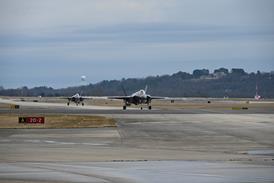The regional aircraft sector has stolen the limelight at recent airshows. A string of blockbuster deals, renewed fierce competition in the market and a raft of new products on the drawing board have made the sector a byword for dynamism. Against this background, British Aerospace Regional Aircraft pursues a policy of putting profitability before market share at all costs and is bringing a derivative aircraft - the Avro RJX - with a modest price tag to market. It's based on the successful RJ programme. Nick Godwin, vice-president, marketing of BAe Regional defends that policy and questions whether the market can support all the regional aircraft projects under way. He also talks about the RJX, heading for entry into service in July 2001, and the potential for a regional market in the Gulf.
Q: Describe your presence and your strategy at Dubai 2000.
A: We have shown aircraft in the past but as a relatively small element of the overall presence of British Aerospace. This year we won't have an aircraft. Our (RJ) programme is fairly mature and there is no real need.
We will have salesmen present and a model of the RJX.
We are very much looking to this future programme now and, of course, could bring the aircraft to the show in 2001. We will have a salesman at the show and we will make good use of the extensive network of BAe contacts throughout the region.
We will be advertising and promoting the Avro RJX, which gives a significant improvement in fuel burn of 15%, 20-30% reduction in engine maintenance and a 17% improvement in range.
Q: What sales have you achieved in the region and what is your future strategy here?
A: We have a BAe 146-200 flying with the Emiri Flight in Abu Dhabi and we have Jetstream aircraft in the region. Our aim is to raise the profile of the RJX in the region because we believe it has considerable potential here.
The region has been slow to free up on the regulatory side as it affects regional aircraft and we believe there remains considerable untapped potential.
Q: Are there any signs that the structural and regulatory limitations that prevent true regional operations in the region might be changing for the better?
A: There clearly remain problems but perhaps we will see a change, possibly with pressure from one of the (airline) marketing alliances that wish to do business in the region.
I believe it will take one or more of the liberal-thinking airlines to take a lead and create the possibility of a regional market because they really want to serve the customer.
Q: What is the BAe perspective on prospects for the broader regional aircraft market?
A: Our prospects are pretty good. If you look at the market, you see real markets in Europe, Australasia and the USA but the USA is influenced by the problem of "scope clauses." We have significant fleets in Australasia and Europe and we are addressing that with the RJX.
Q: There is tremendous competition in the regional aircraft market: what are the criteria for separating the winners from the losers?
A: Some of the all-new regional aircraft programmes being talked about will cost in the order of $850 million to more than a $1 billion. By contrast, the RJX programme will cost $100 million, on a risk-sharing basis with our partners. We believe that is the right way to go. We also believe that we will see programme failures elsewhere.
Q: When you see the huge orders being won by Bombardier and Embraer, do you feel that a different BAe regional strategy might have been different?
A: Not at all. I can't speak for our competitors but we have a profitable business. Our strategy has been to go for profitability rather than market share at any cost. We set ourselves a production maximum of 18 regional jets a year, with the flexibility to go up to 24, and we intend to continue that with the RJX. With the exception of Bombardier, we are the only regional aircraft manufacturer that is run as a business.
Q: What is the current status of the RJX programme?
A: In physical terms the programme is very advanced. The new AlliedSignal AS907 engine will have its first test flight in January next year and the new aircraft will be rolled out in January. It will be flying in the third quarter of next year. We have agreed an eight-month flight test programme which is a very aggressive time frame. On the marketing side, we are talking to existing BAe 146 operators mainly in Europe. We would expect to have two or three order announcements, covering 15 to 20 aircraft, before the end of the year.
Q: On the eve of the new millennium, do you have any particular New Year resolution?
A: To help make the RJX the best regional aircraft around.
Source: Flight Daily News























